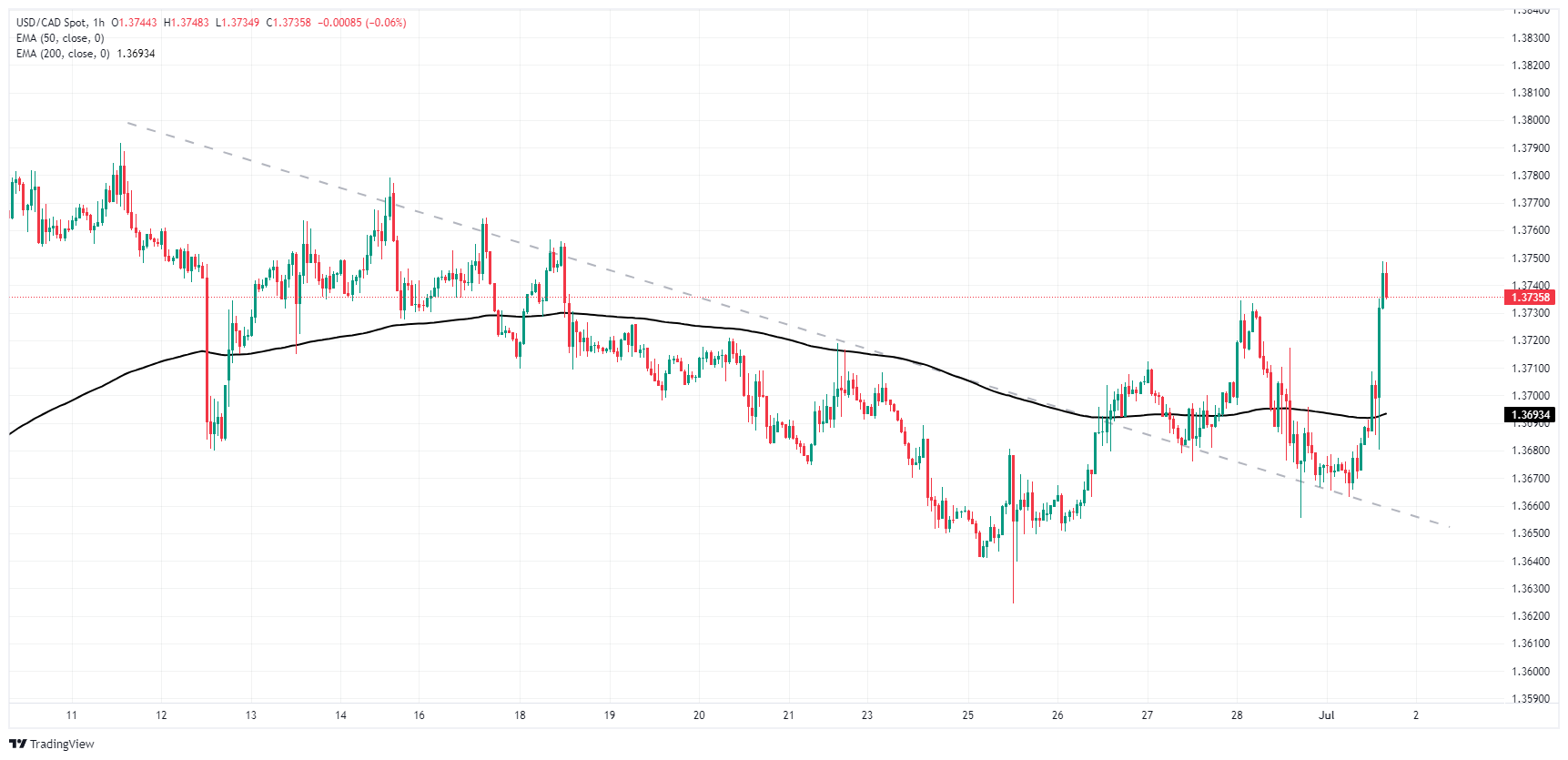- The Canadian Dollar loses half a percent against the Dollar.
- The Canada Day holiday leaves CAD markets in the dark on Monday.
- Canadian data remains limited this week through Friday’s NFP.
The Canadian dollar (CAD) retreated broadly on Monday as Canadian markets were closed for the Canada Day long weekend. CAD traders will return to the market on Tuesday just in time for a new release of S&P Global Canadian Manufacturing Purchasing Managers’ Index (PMI) figures.
Canada has a mostly empty economic calendar this week. Outside of Tuesday’s upcoming PMI release, little of interest comes from the Canadian side until Friday’s jobs figures, which will largely be overshadowed by another round of US Non-Farm Payrolls (NFP).
Daily Moves and Market Movers: Canadian Holiday Leaves CAD Adrift
- Safe-haven bids have broadly strengthened the US dollar on Monday.
- The Canadian Dollar takes pride of place as the worst-performing major currency to start the new trading week.
- The US ISM Manufacturing PMI figures for June came in worse than expected, retreating to 48.5 from 48.7, missing the expected rise to 49.1.
- The US ISM Manufacturing PMI price paid, a measure of industry-level inflation expectations, retreated sharply in June, falling to 52.1 from 57.0, a much steeper drop than the forecast of 55.9.
- Recession fears are limiting risk appetite on Monday as faltering US data tips further into slowdown territory.
CAD current price
The table below shows the percentage change of the Canadian Dollar (CAD) against major currencies today. Canadian dollar was the strongest currency against the Swiss franc.
| USD | EUR | GBP | JPY | CAD | AUD | NZD | CHF | |
|---|---|---|---|---|---|---|---|---|
| USD | -0.15% | -0.08% | 0.45% | 0.46% | 0.20% | 0.37% | 0.60% | |
| EUR | 0.15% | -0.14% | 0.31% | 0.31% | 0.24% | 0.21% | 0.45% | |
| GBP | 0.08% | 0.14% | 0.43% | 0.47% | 0.39% | 0.36% | 0.61% | |
| JPY | -0.45% | -0.31% | -0.43% | 0.00% | -0.19% | -0.09% | 0.18% | |
| CAD | -0.46% | -0.31% | -0.47% | -0.01% | -0.22% | -0.10% | 0.14% | |
| AUD | -0.20% | -0.24% | -0.39% | 0.19% | 0.22% | -0.03% | 0.29% | |
| NZD | -0.37% | -0.21% | -0.36% | 0.09% | 0.10% | 0.03% | 0.27% | |
| CHF | -0.60% | -0.45% | -0.61% | -0.18% | -0.14% | -0.29% | -0.27% |
The heatmap shows percentage changes of major currencies. The base currency is selected from the left column, while the quote currency is selected from the top row. For example, if you choose the Canadian Dollar from the left column and move along the horizontal line to the US Dollar, the percentage change shown in the chart will represent the CAD (base)/USD (quote).
Technical Analysis: Canadian Dollar Falls Across the Board, USD/CAD Finds New Highs
The Canadian dollar (CAD) fell across the board on Monday, losing around half a percent against the US dollar, Australian dollar and British pound. The CAD also lost a fifth of a percent against the Australian Dollar and about a tenth of a percent against the Japanese Yen.
The USD/CAD found a fresh multi-week high after testing the 1.3750 level on Monday. The pair has regained ground after bouncing back from last week’s drop below 1.3630. Still, intraday price action continues to trade choppy as the pair cycles above the 200-hour exponential moving average (EMA).
The daily candlesticks continue to find support above the 50-day EMA at 1.3679, but the bidding pressure will still need to gather enough momentum to break north of the June bid highs just below the 1.3800 zone. .
USD/CAD Hourly Chart
USD/CAD daily chart
The Canadian dollar
The key factors determining the Canadian dollar (CAD) are the level of interest rates set by the Bank of Canada (BoC), the price of oil, Canada’s main export, the health of its economy, inflation and the trade balance, which is the difference between the value of Canadian exports and its imports. Other factors include market sentiment, i.e. whether investors are betting on riskier assets (risk-on) or looking for safe assets (risk-off), with risk-on being positive for the CAD. As its largest trading partner, the health of the US economy is also a key factor influencing the Canadian dollar.
The Bank of Canada (BoC) exerts significant influence over the Canadian Dollar by setting the level of interest rates that banks can lend to each other. This influences the level of interest rates for everyone. The BoC’s main objective is to keep inflation between 1% and 3% by adjusting interest rates up or down. Relatively high interest rates are usually positive for the CAD. The Bank of Canada can also use quantitative easing and tightening to influence credit conditions, with the former being negative for the CAD and the latter being positive for the CAD.
The price of oil is a key factor influencing the value of the Canadian dollar. Oil is Canada’s largest export, so the price of oil tends to have an immediate impact on the value of the CAD. Generally, if the price of oil rises, the CAD rises as well, as aggregate demand for the currency increases. The opposite occurs if the price of oil falls. Higher oil prices also tend to lead to a higher probability of a positive trade balance, which also supports the CAD.
Although inflation has traditionally always been considered a negative factor for a currency, as it reduces the value of money, the opposite has actually occurred in modern times, with the relaxation of cross-border capital controls. Higher inflation typically leads central banks to raise interest rates, which attracts more capital inflows from global investors looking for a lucrative place to store their money. This increases demand for the local currency, which in Canada’s case is the Canadian dollar.
The released macroeconomic data measures the health of the economy and can have an impact on the Canadian Dollar. Indicators such as GDP, manufacturing and services PMIs, employment and consumer confidence surveys can influence the direction of the CAD. A strong economy is good for the Canadian Dollar. Not only does it attract more foreign investment, but it can encourage the Bank of Canada to raise interest rates, which translates into a stronger currency. However, if the economic data is weak, the CAD is likely to fall.
Source: Fx Street
I am Joshua Winder, a senior-level journalist and editor at World Stock Market. I specialize in covering news related to the stock market and economic trends. With more than 8 years of experience in this field, I have become an expert in financial reporting.







